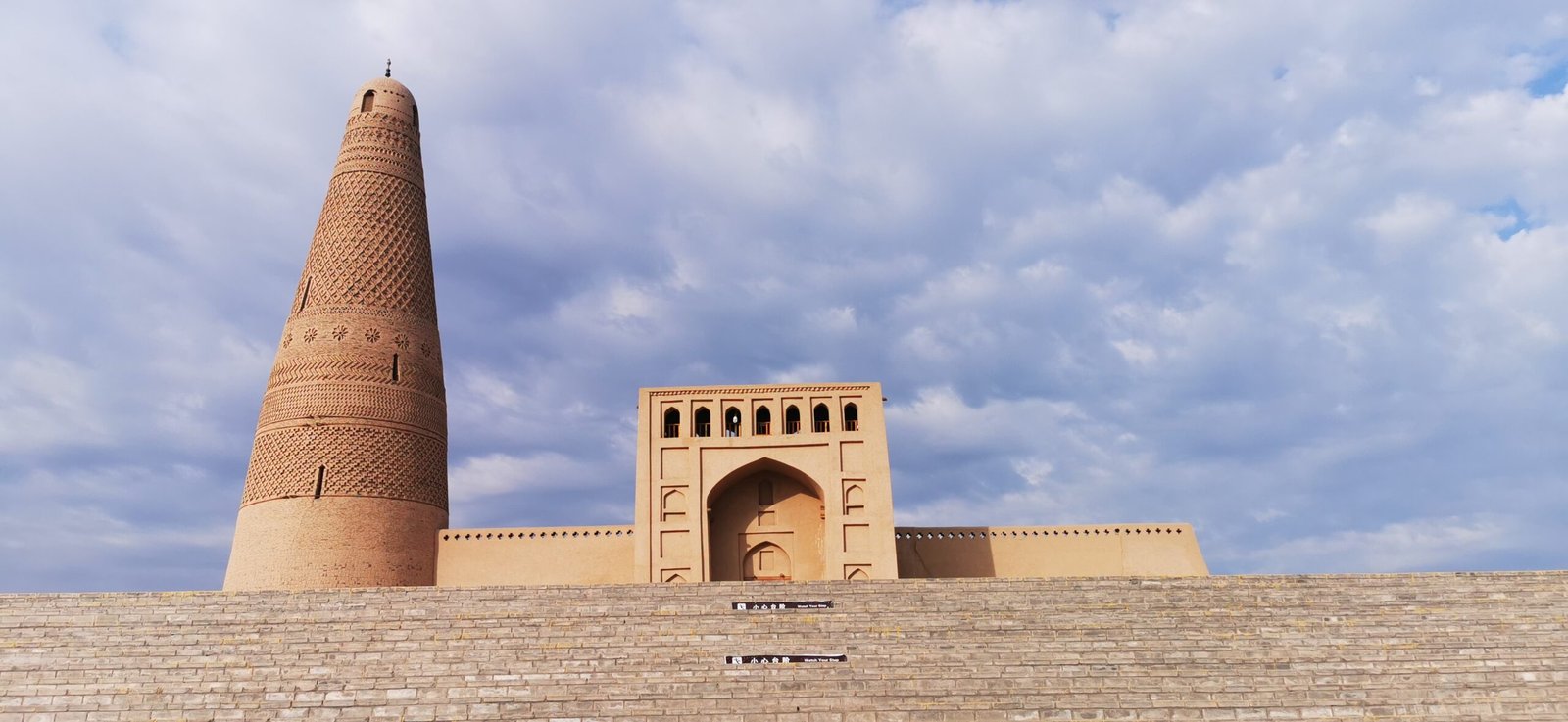Widely Distributed Buddhist Temples in Tibet
Buddhism’s Priority in Tibet
Tibet is synonymous with Buddhism, a faith deeply interwoven with its cultural identity and everyday life. Tibetan Buddhism, also known as Vajrayana, has been the region’s dominant spiritual force for over a millennium. The spread of Buddhism in Tibet began in the 7th century during the reign of King Songtsen Gampo, who established the first Buddhist temples, including the Jokhang Temple in Lhasa. Over time, the religion became an integral part of Tibetan governance, art, and education, giving rise to a vast network of monasteries that underscore Buddhism’s enduring influence.
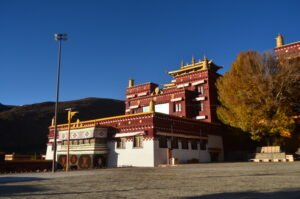
Monasteries in Tibet serve as more than places of worship. They are centers of learning, art, and governance. Monastic education in Tibet involves rigorous study of Buddhist scriptures, philosophy, and debate. These institutions play a pivotal role in preserving Buddhist texts and rituals, ensuring their transmission across generations.
Monasteries Take Predominant Places in Each City
In Tibetan cities, monasteries often occupy central and elevated locations, reflecting their significance. Lhasa, the capital, is a prime example, with the Potala Palace and Jokhang Temple serving as its spiritual and cultural heart. The Potala Palace, once the winter residence of the Dalai Lama, is a sprawling architectural marvel that dominates the skyline. Similarly, smaller towns like Shigatse and Tsetang are defined by their monasteries, such as Tashilhunpo Monastery and Samye Monastery, respectively.
Monasteries are also deeply integrated into the region’s festivals and traditions. During events like the Monlam Prayer Festival and the Butter Lamp Festival, monasteries become vibrant hubs of celebration, drawing locals and pilgrims alike.
Daily Rituals Around Monasteries
Life in Tibet revolves around the monasteries. Pilgrims travel vast distances to perform rituals, such as prostrations, circumambulating holy sites, and spinning prayer wheels. These acts of devotion are seen as a means to accumulate merit and seek blessings. Monks and nuns lead chants, prayers, and ceremonies, creating an atmosphere of profound spiritual energy.
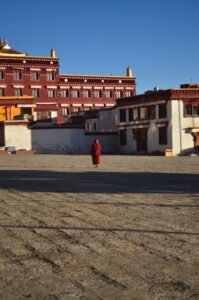
The Kora, or sacred circumambulation, is a key practice for Tibetan Buddhists. Devotees walk around monasteries, stupas, and sacred mountains in a clockwise direction, reciting prayers or mantras. This daily practice not only strengthens their faith but also reinforces the monastery’s role as the focal point of communal life.
Why Are Most Buddhist Temples Located on a Peak?
Demonstrating the Buddhist Nobility
The placement of Buddhist temples on mountain peaks is symbolic of spiritual ascent and enlightenment. According to Buddhist philosophy, mountains are seen as sacred spaces closer to the heavens. By situating monasteries on high terrain, Tibetan architecture reinforces the notion of divine proximity and the supremacy of Buddhist teachings.
Historically, Tibetan leaders and spiritual masters selected elevated locations to emphasize the importance of the Dharma (Buddhist teachings). The grandeur of these settings reflects the nobility and transcendence of the religion, drawing pilgrims who seek inspiration and solace in such majestic surroundings.
The Visual Necessity of Occupying High
From a practical perspective, building monasteries on peaks serves functional purposes. Elevated sites provide natural defenses against potential threats and create a commanding view of the surrounding area. This strategic placement ensures visibility, making the monasteries prominent landmarks.
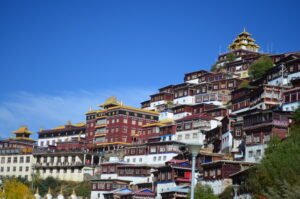
Additionally, the high-altitude locations are ideal for meditation and contemplation. The serene and remote environment allows monks to focus on spiritual practices without distractions. For example, the iconic Tashilhunpo Monastery in Shigatse sits on a hillside, blending seamlessly with its natural surroundings while offering panoramic views.
The Aesthetic Values of Tibetan Buddhist Temples
General Layout of Monasteries
The layout of Tibetan monasteries reflects a harmonious blend of spiritual and practical elements. Central to the design is the assembly hall, known as the Dukhang, where monks gather for prayers and ceremonies. Surrounding the hall are living quarters, storage rooms, and smaller chapels dedicated to various deities. This arrangement fosters a sense of community while accommodating the needs of a monastic lifestyle.
The courtyards within monasteries serve as spaces for debate, a cornerstone of monastic education. Monks engage in lively discussions on Buddhist philosophy, honing their analytical and rhetorical skills. These courtyards, often adorned with intricate murals, are both functional and visually captivating.
Dramatic Combination of Cells and Palaces
Tibetan Buddhist temples are renowned for their dramatic architecture, which juxtaposes humble monk cells with grand palace-like structures. This contrast highlights the dual nature of monastic life: ascetic discipline and spiritual grandeur. The Potala Palace exemplifies this interplay, with its massive red and white walls symbolizing the balance between spiritual authority and human devotion.
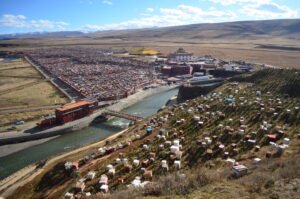
Another remarkable feature is the use of vibrant colors and intricate designs. Tibetan monasteries are adorned with bright hues, elaborate carvings, and Thangka paintings that depict Buddhist deities, mandalas, and scenes from scripture. These artistic elements not only enhance the temple’s visual appeal but also serve as tools for meditation and teaching.
Conclusions
Tibetan Buddhist monasteries are masterpieces of architecture, spirituality, and cultural heritage. Their strategic placement on peaks, intricate designs, and central role in community life make them enduring symbols of Tibetan identity. As places of worship, learning, and artistic expression, these temples continue to inspire awe and devotion among pilgrims and visitors worldwide. Through their grandeur and sanctity, they offer a window into the profound spiritual traditions of Tibet, preserving a legacy that has transcended centuries.

